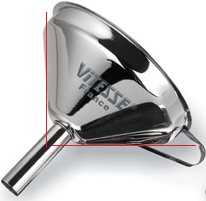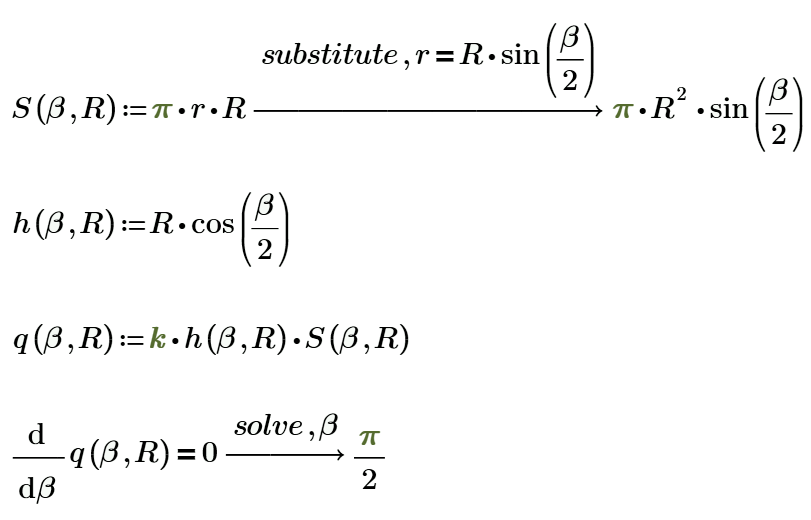Community Tip - Have a PTC product question you need answered fast? Chances are someone has asked it before. Learn about the community search. X
- Subscribe to RSS Feed
- Mark Topic as New
- Mark Topic as Read
- Float this Topic for Current User
- Bookmark
- Subscribe
- Mute
- Printer Friendly Page
One optimization problem with filtration
- Mark as New
- Bookmark
- Subscribe
- Mute
- Subscribe to RSS Feed
- Permalink
- Notify Moderator
One optimization problem with filtration
I have a round paper for filtration with a fixed D.
What size must have a cone for filtration with minimum time:
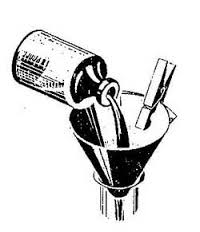
We need numerical, graph & symbolic solutions!
- Labels:
-
Other
- Mark as New
- Bookmark
- Subscribe
- Mute
- Subscribe to RSS Feed
- Permalink
- Notify Moderator
That sure depends. amount of overlap in cone construction (look at the pic), maximum height we allow the cone to be filled (which may depend on the size of the glass underneath, amount of tremor of the experimental leader (=how much will get spilled), maybe even kind of liquid and permeability of material.
- Mark as New
- Bookmark
- Subscribe
- Mute
- Subscribe to RSS Feed
- Permalink
- Notify Moderator
- Mark as New
- Bookmark
- Subscribe
- Mute
- Subscribe to RSS Feed
- Permalink
- Notify Moderator
Werner Exinger wrote:
OK, here is at least the volume optimization.
My old solution:
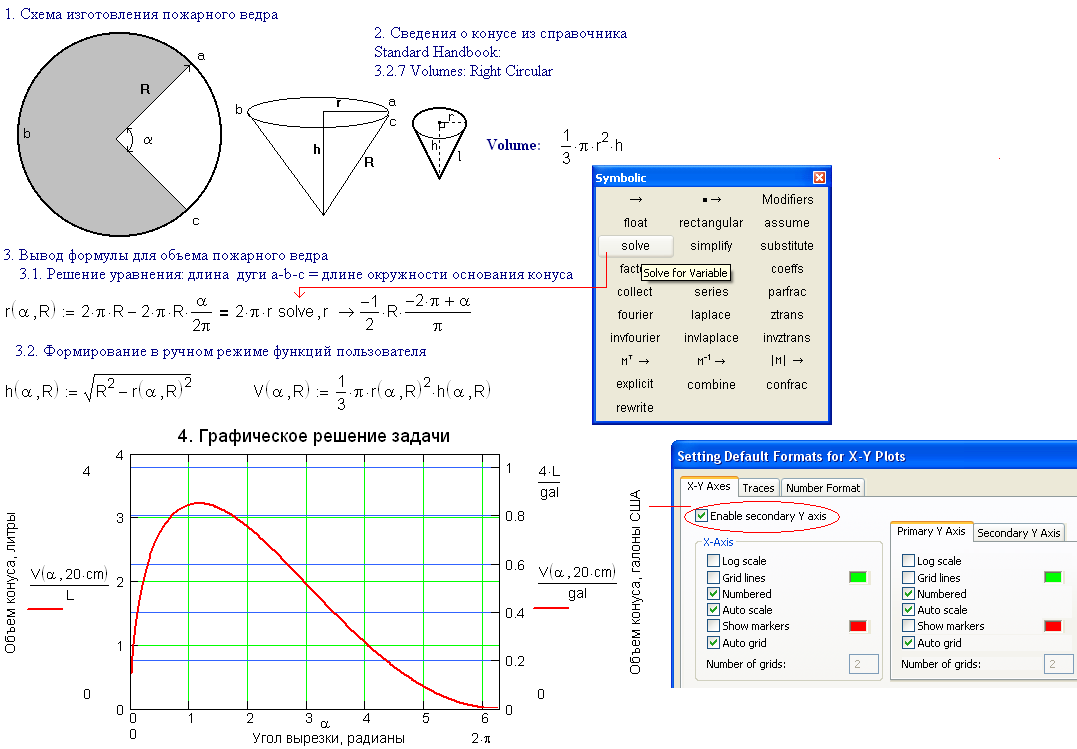
- Mark as New
- Bookmark
- Subscribe
- Mute
- Subscribe to RSS Feed
- Permalink
- Notify Moderator
From one round paper we can make two cones.
One symbolic solution gis problem from Viktor Korobov bellow.
Can 3 cones have more volume?
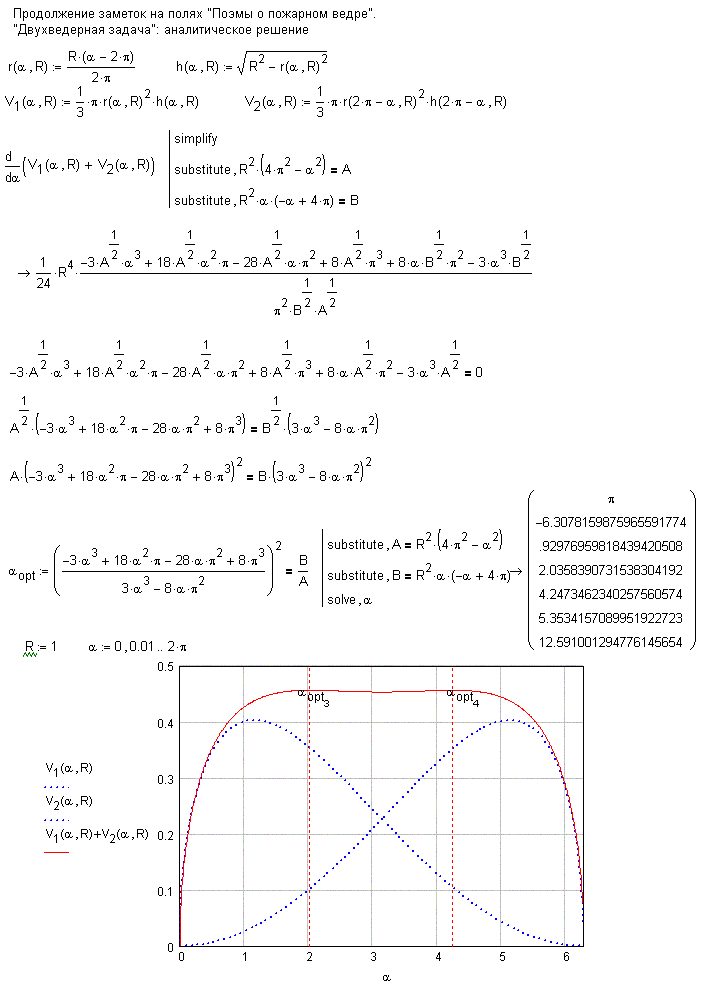
- Mark as New
- Bookmark
- Subscribe
- Mute
- Subscribe to RSS Feed
- Permalink
- Notify Moderator
Can 3 cones have more volume?
No.
With three cones you get one local minumum (three equal sized cones) and by symmetry three saddle points.
The maxima are no local max's but are located at the boundaries which means that one cone would be zero. So you would arrive at Viktor's solution(s).
- Mark as New
- Bookmark
- Subscribe
- Mute
- Subscribe to RSS Feed
- Permalink
- Notify Moderator
Yes:
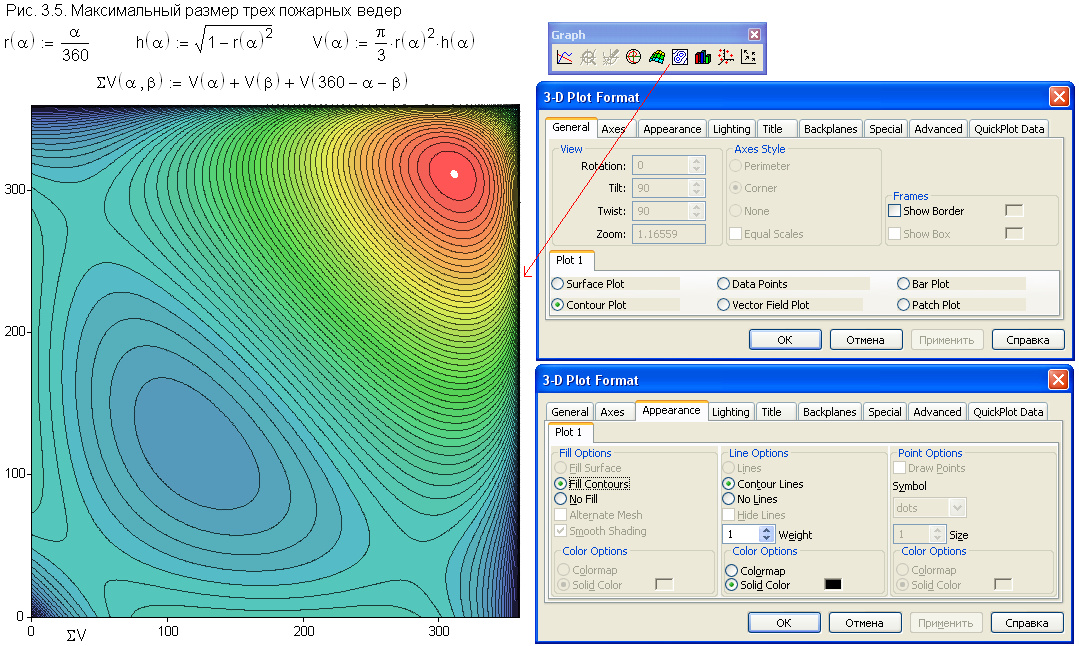
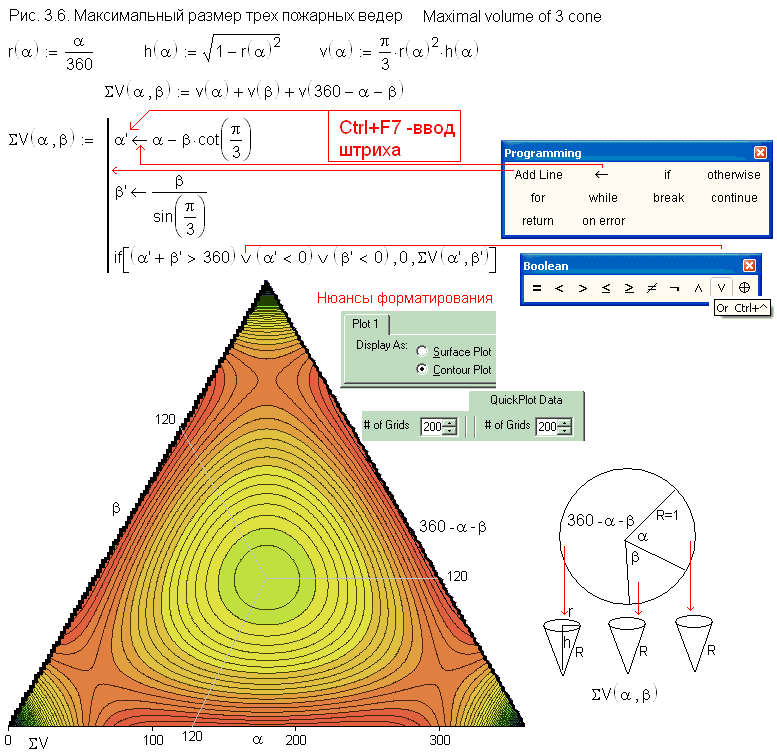
- Mark as New
- Bookmark
- Subscribe
- Mute
- Subscribe to RSS Feed
- Permalink
- Notify Moderator
correct

- Mark as New
- Bookmark
- Subscribe
- Mute
- Subscribe to RSS Feed
- Permalink
- Notify Moderator
We have 6 equal maximums on the perimeter of this triangle!
And we need triangle diagram:
See please http://communities.ptc.com/videos/1427
- Mark as New
- Bookmark
- Subscribe
- Mute
- Subscribe to RSS Feed
- Permalink
- Notify Moderator
Valery Ochkov wrote:
We have 6 equal maximums on the perimeter of this triangle!
And we need triangle diagram:
Not really needed to use an affine coordinate system, but sure convenient.
- Mark as New
- Bookmark
- Subscribe
- Mute
- Subscribe to RSS Feed
- Permalink
- Notify Moderator
Werner Exinger wrote:
Valery Ochkov wrote:
We have 6 equal maximums on the perimeter of this triangle!
And we need triangle diagram:
Not really needed to use an affine coordinate system, but sure convenient.
Not convenient but fine...
But sorry we must find not a max volume but a min time of filtration.
It is one problem from old soviet hand book on Chemistry Engineering. I will try to find this book.
- Mark as New
- Bookmark
- Subscribe
- Mute
- Subscribe to RSS Feed
- Permalink
- Notify Moderator
But sorry we must find not a max volume but a min time of filtration.
Yes, see my comments and implicit request for a more precise specification for the task.
- Mark as New
- Bookmark
- Subscribe
- Mute
- Subscribe to RSS Feed
- Permalink
- Notify Moderator
Filtration time is primarily dependend on the filter surface.
If we maximize filter surface, the solution is of course the "cone" with height zero = the filter disk itself.
You may try to maximize the ratio surface/volume with the same result, of course. It will be maximal for the full disk (volume=0).
So all we could do with the information given is to maximize the volume of the cone for a given disk, which does not really relate to minimum time.
You may specify a filtration rate (volume per area per time) and may take into account that in case of a higher cylinder the filtration rate will not be constant but depends on the height as of the pressure by the overlying liqid in the cone - nice combination using a differential eqation. If the liquid to be filtered does not fit the cone entirely, at what rate is it refilled?.
Furthermore the cone has sections where the filter paper has two, maybe even more layers. How does this affect filtration rate?
Hmm, seems to get too interesting now - time to leave ![]()
- Mark as New
- Bookmark
- Subscribe
- Mute
- Subscribe to RSS Feed
- Permalink
- Notify Moderator
- Mark as New
- Bookmark
- Subscribe
- Mute
- Subscribe to RSS Feed
- Permalink
- Notify Moderator
Q = ?? (surface of the whole cone times half of the height)
- Mark as New
- Bookmark
- Subscribe
- Mute
- Subscribe to RSS Feed
- Permalink
- Notify Moderator
Werner Exinger wrote:
Q = ?? (surface of the whole cone times half of the height)
liter/sec
- Mark as New
- Bookmark
- Subscribe
- Mute
- Subscribe to RSS Feed
- Permalink
- Notify Moderator
Why would Q be proportional to the product of the initial height of the liquid times the total cone surface?
- Mark as New
- Bookmark
- Subscribe
- Mute
- Subscribe to RSS Feed
- Permalink
- Notify Moderator
Werner Exinger wrote:
Why would Q be proportional to the product of the initial height of the liquid times the total cone surface?
The first guess![]()
- Mark as New
- Bookmark
- Subscribe
- Mute
- Subscribe to RSS Feed
- Permalink
- Notify Moderator
Valery Ochkov wrote:
Werner Exinger wrote:
Why would Q be proportional to the product of the initial height of the liquid times the total cone surface?
The first guess
based on ...?
- Mark as New
- Bookmark
- Subscribe
- Mute
- Subscribe to RSS Feed
- Permalink
- Notify Moderator
A velocity of filtration in one element ot thr filter is proportional to the height of the liquid, the number of elements is proportional to the surface.
- Mark as New
- Bookmark
- Subscribe
- Mute
- Subscribe to RSS Feed
- Permalink
- Notify Moderator
Valery Ochkov wrote:
A velocity of filtration in one element ot thr filter is proportional to the height of the liquid, the number of elements is proportional to the surface.
OK, but ..
1) the liquid height is continuously decreasing, so you have a differential equation to solve, as I already wrote in a prior post.
2) The initial height can't be set to a constant percentage (50% in your sheet) of the total cone height but the height has to be calculated based on the dimensions of the cone, assuming the same liquid volume for every case of alpha.
3) The surface involved in your formula should not be the total cone surface but just the surface wetted/covered with liquid. This surface will also decrease over time and has to be calculated using the result of the ODE from 1).
Simplifications:
1) the whole liquid to be filtered fits in the cone without need to repour liquid
2) The time needed to fill the liquid in the filter cone is 0 sec. 🙂
3) The filter paper will have the same permeability throughout the whole process. In reality permeability will decrease depending on the amount of liquid already filtered - again an ODE.
4) Normally you will not cut the filter disk but ruther fold it to make a cone. So there is a segment (angle alpha/3) where we have three layers of filter paper. As a simplification we can asume that the permeability in this area is the same as with the rest.
- Mark as New
- Bookmark
- Subscribe
- Mute
- Subscribe to RSS Feed
- Permalink
- Notify Moderator
Thanks, I see it too.
But The best theory is practice: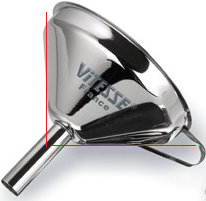
But I see in Internet that the standard angle is 60 deg.
- Mark as New
- Bookmark
- Subscribe
- Mute
- Subscribe to RSS Feed
- Permalink
- Notify Moderator
But we don' t only have the 90° cones but also the 60° ones. Probably only out of convenience as we would only have to fold the filter disc in quarters to use it. But still we are not sure which one is the speediest.
- Mark as New
- Bookmark
- Subscribe
- Mute
- Subscribe to RSS Feed
- Permalink
- Notify Moderator
- Mark as New
- Bookmark
- Subscribe
- Mute
- Subscribe to RSS Feed
- Permalink
- Notify Moderator
What do you get when you multiply cone surface, cone height and Boltzmann?
- Mark as New
- Bookmark
- Subscribe
- Mute
- Subscribe to RSS Feed
- Permalink
- Notify Moderator
Werner Exinger wrote:
What do you get when you multiply cone surface, cone height and Boltzmann?
Sorry, it is not Boltzmann - it is simple k in this problem: q is proportional delta pressure and surface.
- Mark as New
- Bookmark
- Subscribe
- Mute
- Subscribe to RSS Feed
- Permalink
- Notify Moderator
Unless you have defined a constant k above the regions shown in your pic it IS the Boltzmann constant. Take a closer look. It formatted as constant and contrary to Mathcad, the Boltzmann constant is built into Prime.
But Boltzmann or not - the question remains: What do you get by the product of cone surface, cone height and any constant? Whats the meaning of your function q which you maximize?
- Mark as New
- Bookmark
- Subscribe
- Mute
- Subscribe to RSS Feed
- Permalink
- Notify Moderator
One simple model (a first guess): q is proportional delta pressure and surface.
- Mark as New
- Bookmark
- Subscribe
- Mute
- Subscribe to RSS Feed
- Permalink
- Notify Moderator
I see, but pressure (liquid height above point) is not constant for all surface points!
- Mark as New
- Bookmark
- Subscribe
- Mute
- Subscribe to RSS Feed
- Permalink
- Notify Moderator
It is a mean value.
We have an integral and a triangle.



